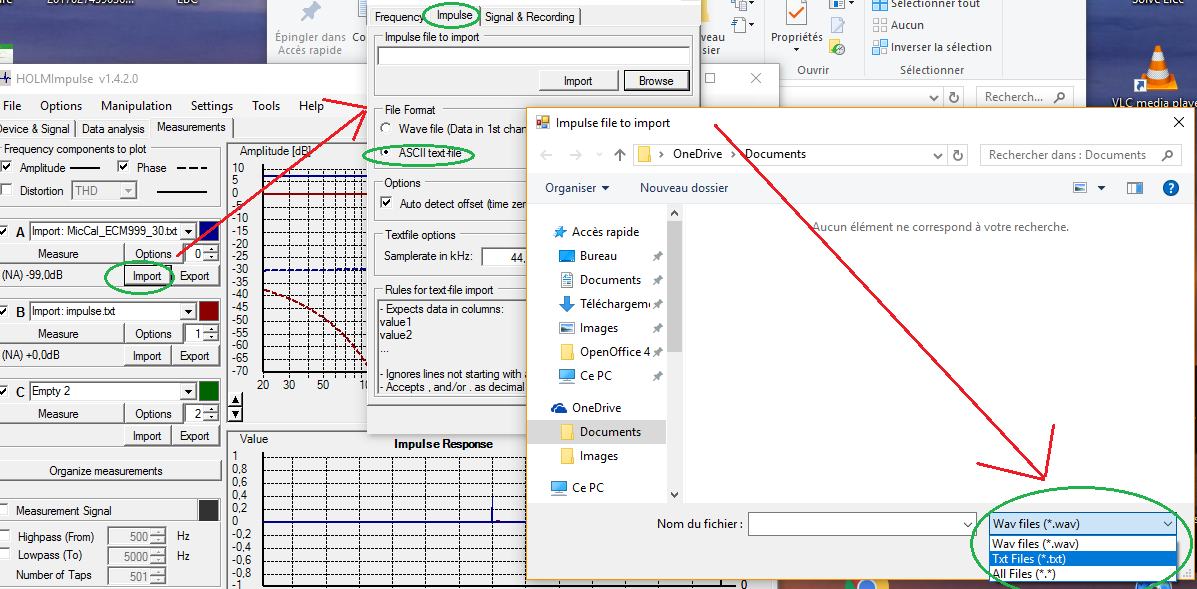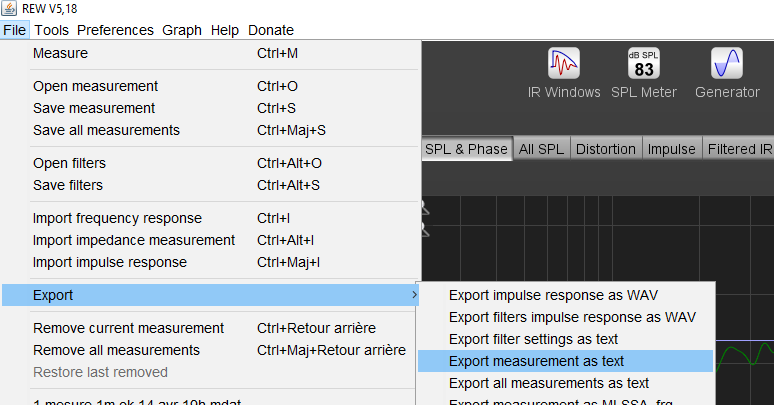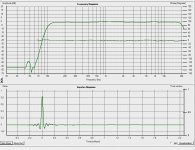HOLMImpulse takes a different approach. By default it centers the impulse of each measurement. You can choose how it centers the, default is 1st peak, IIRC.Coming from a smaartlive background, I couldn't imagine going about it any other way
However, you can choose not to center the impulse, which would show you total delay. Or you can center the impulse on one measurement, say the midrange driver, then lock the time and see the offset of subsequent measurements. That would be similar to what REW is doing with the calibration.
I keep trying to use/learn HOLM, it looks very capable.
But crashes and lockups are regular (win 10). Maybe I'm just missing something with file formats, etc......
When you use HOLM, do you make measurements directly with it? Or with REW, and import the measurements?
Just tried a simple import of a txt file measurement made in REW....lockup.
Any trouble shooting ideas?
But crashes and lockups are regular (win 10). Maybe I'm just missing something with file formats, etc......
When you use HOLM, do you make measurements directly with it? Or with REW, and import the measurements?
Just tried a simple import of a txt file measurement made in REW....lockup.
Any trouble shooting ideas?
I used to get lockups in W10 and W8 but not much anymore. I do not know what changed. Maybe a .Net update?
There are still certain file formats that will crash HOLM on import. Mostly I measure in HOLM because I've used it so much it's very familiar. And being impulse based it seems to mesh well with rePhase
There are still certain file formats that will crash HOLM on import. Mostly I measure in HOLM because I've used it so much it's very familiar. And being impulse based it seems to mesh well with rePhase
In a way think they can but REW need so much smoothing for "GD" curves to be readable that not sure how to trust for timing drivers acoustic offsets.
For fun did a guess on your band-pass above have MB/MID/TW turned on with LR8 slopes at 180/650/4000Hz and BW2 stop-band at 20kHz, created in Rephase. Importing this IR model to REW show below curve and if we compare it looks your purple and green comes closest, gold is too slow and the ones firing before real-time is too advanced : )
Thank you GURU!
Ustas, with REW, I use either acoustic or loopback timing references to determine delay.
Usually locates within a few samples. Coming from a smaartlive background, I couldn't imagine going about it any other way
Biggest problem is always finding subs... I measure raw with the acoustic timing signal jacked up (level can be set independently from measurement levels). Then add group delay figured from electrical xover. Bottom line with subs IMO, is that you just keep varying delay until phase traces overlay.
This is where real time, dual FFT measurements, make life easy.
For my SUB ch. I have trick... I use 3 frequency generators and REW RTA(spectrum mode). Playing 3 frequencies at the same time : "central point" (exactly XO freq), "left side" (-3dB theoretical XO freq of HP filter)" and "right side" -3dB theoretical XO freq of LP filter). On RTA we can see whats happened when we change delays. Stop tuning when achieve maximum values on RTA. Also need to verify minimums with inverted polarity.
Last edited:
I keep trying to use/learn HOLM, it looks very capable.
But crashes and lockups are regular (win 10). Maybe I'm just missing something with file formats, etc......
only way is to export impulse (from rePhase) as .txt (not .wav).
And choose the .txt format with Holm.

Also,to make manipulations with Holm (1/A or A*B or other).
Need to save the measurements before,re-import measure right after.
(don't know exactly how Holm stocks the measure after the sweep/MLS).
it is not workable for math operation between import and measurement.
It's working with 2 measurements,or 2 imports but not the mix.
Sometimes (often),a reset parameter with Holm is helpful.
Holm--->options--->reset settings (at the bottom of the list,below "miscenalous").
Need to save the measurements before,re-import measure right after.
(don't know exactly how Holm stocks the measure after the sweep/MLS).
it is not workable for math operation between import and measurement.
It's working with 2 measurements,or 2 imports but not the mix.
Sometimes (often),a reset parameter with Holm is helpful.
Holm--->options--->reset settings (at the bottom of the list,below "miscenalous").
Last edited:
That's strange Thierry. I have no problem exporting impulse waves from HOLM and bringing them into ARTA or REW. And no problem using the measurement manipulations, either. I wonder if it depends on the OS, the .Net installation or something else?
Really too bad HOLM got dropped. It's a really nice bit of software.
Really too bad HOLM got dropped. It's a really nice bit of software.
Hi Pano
Yes it's strange.
Holm is a very fine software,deeply learning correlation between frequency and time domain.(simultaneously).
 Just need to take care of files format.
Just need to take care of files format.
No issues to export.But import impulses is a bit tricky.(XP,Win7,Win10).
Maybe Dot's or comma's compatibility,i've tried all the path.
Don't know.
Yes it's strange.
Holm is a very fine software,deeply learning correlation between frequency and time domain.(simultaneously).
No issues to export.But import impulses is a bit tricky.(XP,Win7,Win10).
Maybe Dot's or comma's compatibility,i've tried all the path.
Don't know.
Hey thx Thierry38, Pano,
OK, got it to import txt impulses from REW by removing all the information in the txt files, before the data begins.
Wav impulses cause an immediate crash (with the file type changed to wav in Holm)
On freq & phase imports... txt files will import after info removal as above, but they show perfect flat line freq response and phase, along with perfect impulse. So somehow data is not being read correctly ?
At least one type import, impulse via txt, is working
OK, got it to import txt impulses from REW by removing all the information in the txt files, before the data begins.
Wav impulses cause an immediate crash (with the file type changed to wav in Holm)
On freq & phase imports... txt files will import after info removal as above, but they show perfect flat line freq response and phase, along with perfect impulse. So somehow data is not being read correctly ?
At least one type import, impulse via txt, is working
Hi Mark,
Is it dot or comma for decimal separator ? (frequency domain file)
text header is removed ?
If you can show the file.(time domain)
Hi Thierry, don't know why, but tab separator works for frequency domain import, and space doesn't . But it works !
If I can get a wav impulse file to import , ALL systems go.
Don't know what you mean by show the time domain file...how do I show a wave? (Space separated works for txt impulse import.)
BTW, here's a screenshot of HOLM import of latest REW meas (FDW6 I think)...
This is using the jriver ID running 65k taps per channel.
Attachments
...BTW, here's a screenshot of HOLM import of latest REW meas (FDW6 I think)...
This is using the jriver ID running 65k taps per channel.
That is what i call by the book precision and great work, in that spot in space must sound fantastic and hope you get this kind of performance spread into wider area too.
Yep, textbook for one spot...that's too close to listen to haha...about 4ft.
It minimizes room reflections there....
(but certainly does sound dang good out in room
I wanted to get as close to ideal response as I could, because now, without moving mic etc, I'm taking the rePhase files that are in jriver's convolution running 65k taps per channel , and regenerating the exact same files at 6144 taps per channel, to run in the openDRCs.
Want to see how my two 'best current alternatives' measure and sound...
PS...thx for the kind words!
HOLMImpulse takes a different approach. By default it centers the impulse of each measurement. You can choose how it centers the, default is 1st peak, IIRC.
However, you can choose not to center the impulse, which would show you total delay. Or you can center the impulse on one measurement, say the midrange driver, then lock the time and see the offset of subsequent measurements. That would be similar to what REW is doing with the calibration.
Until know I have used Holm to export impulse responses, but Im not sure whether or not my method is best practice.
In Rephase i can see a decent flat phase, which is relatively easy to flatten out ie. no odd wrinkles except around the tuning point for the box (as should be). I guess this point to being a good basis measurement/impulse, but Im not sure how to best center the offset. I quess if the offset is not set as it should, the sound will not be as good as can be. I have tried different offset (both in Holm and Rephase)(can not remember the exact settings) - and there is clear audible difference - But when I do not now the best method/now how things are working, my testing is random. Off course my ears let me now if something is not right, but it is forth and back.
My system is multiway ie tweeter, mid/bass and subwoofer.
How do you guys export impulse response files from REW or Holm (would like to know methods in both) ready to import in Rephase => Ie what is the exact settings/methodology to do this? (there seems to be a low of variables to adjust). As I see it:
1) Setting the device up (settings in holm/REW)
2) Manipulate the specific measurement (Gating, offset, time zero locked etc) (holm/REW)
3) settings when exporting the impulse response (Holm/REW)
I have not found a good article about doing it right, before even working with Rephase.
Som screenshots would be very welcome- and I think that a lot of people would benefit from it (Guess I am not the only person who have not figured this process out).
Hello,
it can be a long way to describe universal walktrough.
Use the measurement.txt file (frequency domain),file contains 3 columns (frequency---magnitude---phase).
drop out the text header (information) with any text editor .
more tricky operation is to get a proper/clean acoustic measurement
gating,try about 80~100ms on the left and right side of t=0,flat top window seems to working fine in every case,and 1/3 (or 1/6) octave smoothing.
or frequency dependent window (warning...).
to export from REW,as shown below.(take a look at the text delimter,(space))

it can be a long way to describe universal walktrough.
Use the measurement.txt file (frequency domain),file contains 3 columns (frequency---magnitude---phase).
drop out the text header (information) with any text editor .
more tricky operation is to get a proper/clean acoustic measurement
gating,try about 80~100ms on the left and right side of t=0,flat top window seems to working fine in every case,and 1/3 (or 1/6) octave smoothing.
or frequency dependent window (warning...).
to export from REW,as shown below.(take a look at the text delimter,(space))

Last edited:
Hi
My raw driver response measurements used loopback timing reference in REW.
All drivers were measured with the mic at 1m and at tweeter height.
Can the difference between "system delay" values reported by REW be used as the timing alignment delay between the drivers?
Hi, Yes.
IME, loopback timing ref differences in raw measurements closely reflect physical offsets, providing lower freq drivers reach high enough to get a good timing "lock". You can tell a good "lock" by running several sweeps and seeing if the time delay stays consistent...
And then with the delays in place, if you use linear-phase xovers, timing should be very close to correct. Fine tune it, a few samples at a time, until you get the flattest phase line through x-over you can.
If use use minimum phase x-overs, you will need to do further timing work. But I don't know why you'ld use minimum phase x-over unless you are planning on an entire speaker summed phase correction,..... instead of driver by driver.
I moved this subject to its own thread, as I think it deserves its own space.
I also don't want to detract from the subject of this thread, as I was hoping for a couple quick links to products that managed to measure their phase directly, but it doesn't seem to be the case.
http://www.diyaudio.com/forums/equi...t-microphones-phase-response-calibration.html
Thank you all for your input and feel free to chime in in the new thread.
I also don't want to detract from the subject of this thread, as I was hoping for a couple quick links to products that managed to measure their phase directly, but it doesn't seem to be the case.
http://www.diyaudio.com/forums/equi...t-microphones-phase-response-calibration.html
Thank you all for your input and feel free to chime in in the new thread.
- Home
- Design & Build
- Software Tools
- rePhase, a loudspeaker phase linearization, EQ and FIR filtering tool
